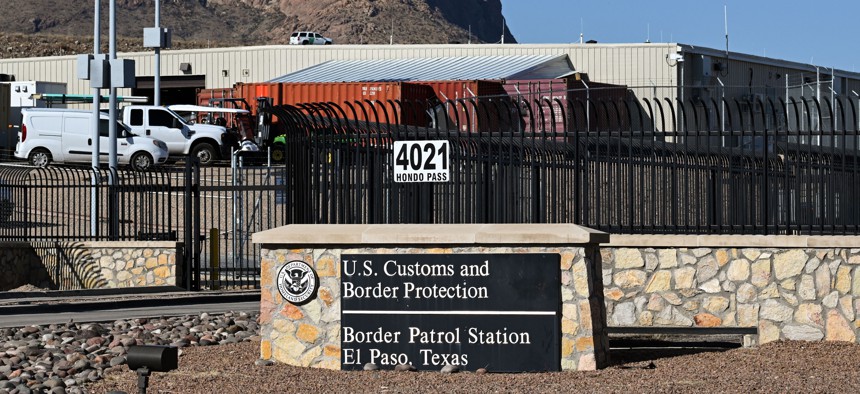
The U.S. Customs and Border Protection Border Patrol Station for processing migrants after they cross the US-Mexico border in El Paso, Texas, on Dec. 19, 2022. PATRICK T. FALLON/AFP via Getty Images
Increasing Drug Seizures and Improving Tech Will Require More Federal Personnel, Officials Say
Resources at the border are growing and the Biden administration wants the staffing to match.
As screening technology at the southern U.S. border improves and drug interdictions continue to skyrocket, Biden administration officials told lawmakers on Wednesday their agencies will require more staffing and resources to follow up with investigations that address criminal activity at the source.
A House Oversight and Accountability Committee hearing focused on “force multipliers” such as new tech and canine teams that improve the effectiveness of customs, border and immigration personnel, but top officials said those augmentations will ultimately only add work for Homeland Security Department and other federal employees. Customs and Border Protection seized nearly 15,000 pounds of fentanyl in fiscal 2022, more than tripling the total from just two years prior. Diane Sabatino, CBP’s deputy assistant commissioner in the Office of Field Operations, said her team is set to eclipse last year’s total by mid-Spring.
Sabatino stressed that represented just one step in the process.
“We can't wait for these things to come to our ports of entry,” she said. “We're not going to seize our way out.”
Instead, she called on members of the committee’s panel on National Security, the Border and Foreign Affairs to “make investments in intelligence resources.”
The “intel research specialists who can operationalize information, put the jigsaw puzzle of intel together to provide to our analytical units at our ports to target more effectively,” would be key going forward, she explained.
Sabatino added that CBP currently inspects 1% to 2% of personal vehicles coming across the southwest border and 15% to 17% of commercial vehicles. Within the next three years, she said, CBP expects to use new, non-intrusive technologies to increase those rates to 40% and 70%, respectively. Such an increase is also likely to require additional personnel and resources.
Anthony Salisbury, the deputy executive associate director at Homeland Security Investigations, said his agency will need more manpower to follow up on various leads that new tech creates.
“Technology will never replace the men and women actually pursuing what the technology uncovers, so we will inevitably need more agents in the field working these investigations,” Salisbury said. “Certainly as we increase our investigative capabilities and our technology capabilities, it's going to require more agents to back that up.”
Already, he said, his agents are at maximum capacity.
“Personnel is always the issue,” Salisbury said. “There are a lot of cross border crimes. We can get spread thin.”
Wednesday’s hearing marked the second time in as many months top border personnel went to Congress asking for additional staffing. President Biden—who will release his fiscal 2024 budget on Thursday—last week promised to secure more resources for DHS.
Sabatino noted the fentanyl crisis and other border issues require a whole-of-government approach and CBP is working with HSI, the Drug Enforcement Administration and the intelligence community, as well the departments of Justice and Defense. When one part of the system expands its capacity—such as in 2019 when CBP received more than a half a billion dollars to improve its technology at ports of entry—it can create additional strains on the rest.
“As CBP deploys new technology in the southwest border ports of entry, it will likely increase the number of CBP origin seizures,” Salisbury said. “As a result, HSI will need additional staffing to support the investigations and prosecutions of port of entry seizures.”
CBP will soon find itself with some new resources. The 2021 Infrastructure Investment and Jobs Act gave the agency $330 million to update its ports of entry, with an additional $3.4 billion for the General Services Administration to support those projects. The 2023 omnibus appropriations bill provided funding for Border Patrol to hire 300 new agents—the first such increase in more than a decade—and gave the Office of Field Operations money to offset shortfalls from its fee collections that the agency had warned could lead to furloughs.
Sabatino said OFO is up to nearly 500 canine teams, with 118 currently in training and expected to deploy soon. It is authorized for 50 more and expects to hire for those roles this year. She added that technological improvements will free up employees from administrative burdens to instead focus on more pressing law enforcement duties.
Several lawmakers expressed concerns with technological advancements, suggesting facial recognition programs contain racial biases and that the mobile application the Biden administration is increasingly requiring for migrants frequently does not work or is difficult for immigrants to use. Sabatino said CBP has already built many improvements to the app to address concerns and offered to further brief lawmakers on the agency’s progress.







